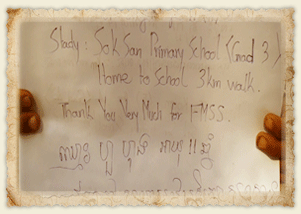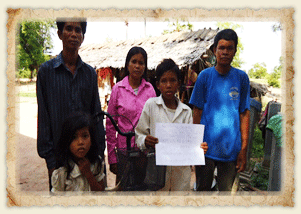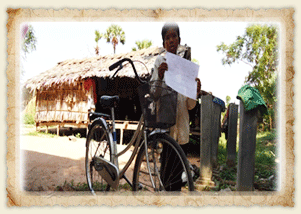Angkor Empire was probably the largest civilization of its time in the world and one of the key contributing factors was due to its mastery over the control of water from the Mekong River. Being situated in the tropical Monsoon zone, the Angkor was subjected to a wet season with heavy rainfall during Monsoon and a dry season during the off-Monsoon period.
Due to their engineering genius, the ancient Khmers built extensive irrigation and drainage system in order to manage the excessive water from the flood. This water was stored in the huge reservoirs such as the East and West Baray, and irrigated the farmlands during the dry period. In this way, the Angkor were able to cultivate and harvest rice crops two or three times in one year. Such a high productivity of rice crops in a year helped to strengthen the country's economy significantly, and thus enhanced its prosperity. This enabled successive god-kings of the Angkor Empire to mobilize large number of labourers and slaves to undertake impressive temple construction, several of which required over tens of thousands of labourers and took them over 20-30 years to complete.
Inspired by the examples of Angkor, the French colonial and followed by the Sihanouk period (1953 – 1970) administration restored and promoted upgrading of water management projects but many did not reach feasibility stage before war broke out.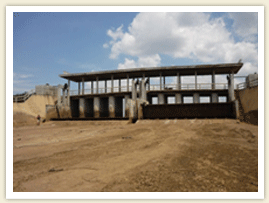
Rice continued to be the state's economic basis under the Khmer Rouge regime (1975-1979). Almost the entire population was forced to grow rice during the wet season and to construct water management and irrigation systems during the remaining 5-8 months of the year. The country was to be turned into a super irrigation system, to become independent of rainfall. However those with the required technical knowledge had either fled, been killed or were not consulted during this process. Today, more than 30 years after the Khmer Rouge regime, it is clear that only a small percentage of these structures can be incorporated in any future water management system, and they will require much additional investment. Most of the structures are useless or, even worse, disruptive to water management.
According to UNICEF, 70% or 9.7 millions of Cambodian inhabitants do not have access to clean, uncontaminated drinking water. Measuring by any standard, water in Cambodia is contaminated and undrinkable without proper treatments. This is typically true in the rural areas where people drink water from rice paddies, ponds, and shallow wells (surface water). This surface water is contaminated with chemicals in fertilizers, insecticides, animal faeces, 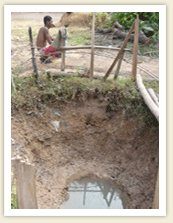 and human waste. The lack of clean drinking water contributes to health problems.
and human waste. The lack of clean drinking water contributes to health problems.
In Cambodia, 1 in 7 children die before the age of five from preventable diseases such as typhoid, malnutrition, malaria, dengue. The common denominator in many of these is waterborne illness. Often when a child gets sick, the parents will self administer local traditional medicine due to poverty and distance to the clinic. Even if they make it to the health clinic, it is often out of proper medicine. By the time the desperate parents bring the child to the hospital in the city, it is already too late to save the child's life. Thus it is most relevant and vital that villagers must have accessible to clean water to prevent child mortality.
You Can Help
Though it will take an immense amount of effort and financial commitment to solve the country's water problem, you can contribute with a small contribution to help save lives of Cambodian families especially those in the rural regions where the majority of Cambodians live.
Instant Clean Water!
Bio Sand Filtration
A simple yet efficient way to obtain clean water using the traditional principle of sand filtration. Bio sand filters remove 95 – 99 % of organic contaminants, including bacteria, viruses, protozoa, worms, and particles. Safe water produced by the filters is free of 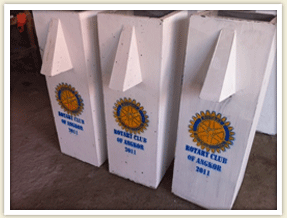 discoloration, odor, and unpleasant taste, and can be used for drinking, food preparation, personal hygiene, and sanitation. Most common home-based models can produce 20 - 60 litres of water per hour.
discoloration, odor, and unpleasant taste, and can be used for drinking, food preparation, personal hygiene, and sanitation. Most common home-based models can produce 20 - 60 litres of water per hour.
With a bio sand filtration unit, a few families can share in the simple maintenance of the unit at zero cost that can last more than 10 years while reducing incidence of diarrheal diseases by up to 40%.
Learning Journeys (Cambodia) Foundation collaborates with the Rotary Outreach Water Program and Trailblazer Foundation in selecting and setting up filtration units through fund (at less than USD100 per unit) sought from donors.
Rain Harvesting Storage
In Cambodia, it is common to see water jars located next to houses underneath the roof
gutters. In a nation where monsoon rain brings plentiful of water, it is natural and essential for local villagers to collect rain for use. Though the quality may be questionable, it is still consider safe and non contaminated. In many areas throughout the country there is no accessible ground water or it is unsuitable for drinking due to high salinity, high iron levels or other contaminants such as arsenic.
However many villagers do not own proper or large enough water storage jars that can hold enough water for sufficient consumption. Also the villagers are not properly taught how to harvest rain safely or given proper simple tools for such purpose.
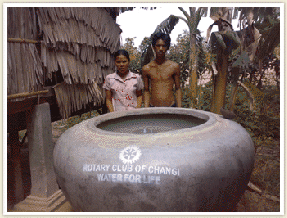 According to the World Health Organization (WHO) of the United Nations, people have a minimum water requirement of about 20 l per person per day. This is the minimum amount needed for physiological rehydration, cooking, washing and other subsistence requirements. However, the WHO estimates that nearly two billion people consume contaminated water. This carries a significant risk of developing such water-borne diseases as cholera, dysentery, polio or typhoid, which kill about 25 million people per year. Both conservation and sanitation are obvious necessities in meeting the huge demand for freshwater.
According to the World Health Organization (WHO) of the United Nations, people have a minimum water requirement of about 20 l per person per day. This is the minimum amount needed for physiological rehydration, cooking, washing and other subsistence requirements. However, the WHO estimates that nearly two billion people consume contaminated water. This carries a significant risk of developing such water-borne diseases as cholera, dysentery, polio or typhoid, which kill about 25 million people per year. Both conservation and sanitation are obvious necessities in meeting the huge demand for freshwater.



 and human waste. The lack of clean drinking water contributes to health problems.
and human waste. The lack of clean drinking water contributes to health problems. discoloration, odor, and unpleasant taste, and can be used for drinking, food preparation, personal hygiene, and sanitation. Most common home-based models can produce 20 - 60 litres of water per hour.
discoloration, odor, and unpleasant taste, and can be used for drinking, food preparation, personal hygiene, and sanitation. Most common home-based models can produce 20 - 60 litres of water per hour.  According to the World Health Organization (WHO) of the United Nations, people have a minimum water requirement of about 20 l per person per day. This is the minimum amount needed for physiological rehydration, cooking, washing and other subsistence requirements. However, the WHO estimates that nearly two billion people consume contaminated water. This carries a significant risk of developing such water-borne diseases as cholera, dysentery, polio or typhoid, which kill about 25 million people per year. Both conservation and sanitation are obvious necessities in meeting the huge demand for freshwater.
According to the World Health Organization (WHO) of the United Nations, people have a minimum water requirement of about 20 l per person per day. This is the minimum amount needed for physiological rehydration, cooking, washing and other subsistence requirements. However, the WHO estimates that nearly two billion people consume contaminated water. This carries a significant risk of developing such water-borne diseases as cholera, dysentery, polio or typhoid, which kill about 25 million people per year. Both conservation and sanitation are obvious necessities in meeting the huge demand for freshwater.

